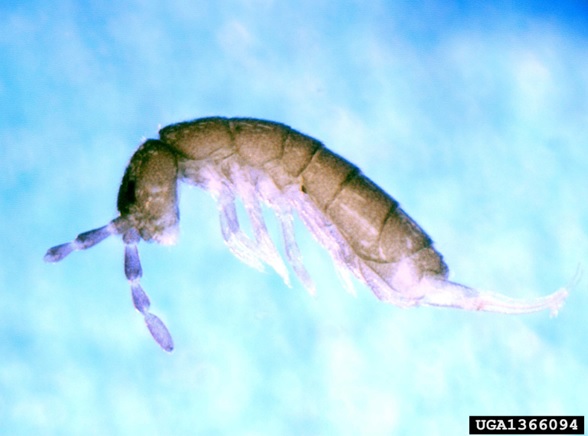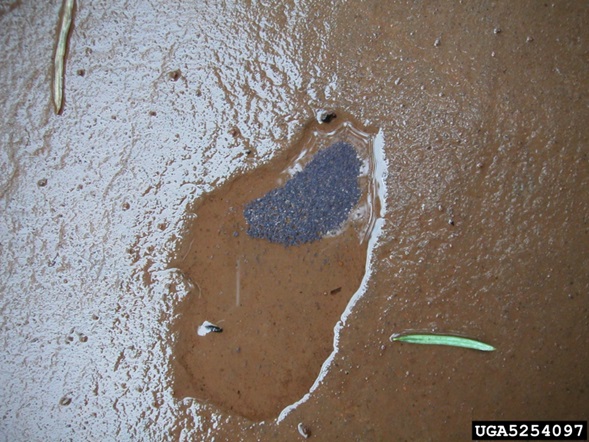Springtails
ENTFACT-420: Springtails | Download PDF
Hannah Blevins, Graduate Research Assistant
Jonathan Larson and Zachary DeVries, Extension Specialists
Fast Facts
- Springtails are small arthropods that get their name from their ability to jump.
- While springtail infestations can cause annoyance, springtails do not bite or sting humans or animals, and there is no evidence suggesting that springtails will form parasitic relationships or transmit disease.
- Springtails can be found in areas that are damp or moist, such as under leaf litter. They may be found indoors in basements, greenhouses, or inside the moist soil of potted plants.
- Infestations can be controlled by limiting dampness within or around the home, such as by improving ventilation, drying out potting soil, reducing mulch depth, or by physically removing springtails from the home via cleaning and sweeping.
Introduction
Technically, springtails are not insects as they are not members of the class Insecta. However, they are terrestrial arthropods that make up the order Collembola. Springtails are very small, with body sizes ranging from 0.02 inches to 0.4 inches in length1. Springtails can be found in a variety of climates and ecosystems, with some species being adapted to survive in arctic and subarctic environments1. Within their ideal habitat and environmental conditions, springtails are able to rapidly reproduce. In indoor environments such as homes and greenhouses, this rapid reproduction can lead to infestations.

Identification
A feature that distinguishes springtails from other arthropods is a small body part known as a furcula. The furcula clasps underneath the springtail’s abdomen, and when it is released, the built up energy causes the springtail to spring into the air1. This is why the name “springtails” was given to these small arthropods.
One insect group that springtails can potentially be confused with are fleas. This is because both springtails and fleas can be found indoors, and both are seen as small jumping insects. However, there are visual differences between the two. Fleas are always a dark, reddish-brown color, with laterally flattened (side-to-side) hard bodies. In contrast, springtails can be found in a variety of colors, appearing gray at first glance, and have softer bodies. Fleas are typically around 1/8 inch long, about half the size of a grain of rice, while springtails are typically the size of a mustard seed or smaller. Springtails feed on decaying organic material and do not bite humans, however, fleas will feed on human blood, leaving small red bite marks along the legs and ankles.

Where Springtails are Commonly Found
While there are many species of springtails that are found in a variety of habitats throughout the world, people living in the U.S. are most likely to see springtails outdoors inhabiting moist, dark areas, such as underneath leaf litter or fallen logs. This is because a springtail’s diet consists of mainly algae, fungi, and decaying organic matter, and they are also highly dependent on a consistent water source1. Indoors, springtails are often found in damp areas such as basements, surrounding leaking pipes, in sinks and bathtubs, surrounding drains, or in newly constructed homes with wet plaster1. They can also be found living in damp soil in house plants and greenhouses.
While springtails tend to aggregate in areas of standing water, such as drains, they often move to these areas after entry into the home via another route. Common places of entry include through gaps around the windows, doors, and garage doors. Springtails may also be brought into the home with damp soil for indoor potted plants.
Relationship Between Springtails and Humans
To date, there have been no verified reports of springtails causing bodily harm to humans or animals, such as by biting or stinging. While there have been a few reported cases of skin irritation from direct handling of springtails2, this is very uncommon, and there have been no reported incidences of skin irritation from passive contact of springtail hairs or scales in the home.
In the outdoor environment, springtails are primarily considered to be beneficial organisms as they play an important role in decomposition of decaying plant matter, breaking down detritus into fertile soil. There is one species of springtail, Sminthurus viridis, that is currently considered an agricultural pest species in Australia due to the damage they cause to crops3. However, there are no species of springtail that are currently considered to be a major agricultural pest in the United States, although they can be an issue with commercial mushroom production.

Springtail Management
Habitat manipulation is typically the best course of action for removing springtails from structures4. Controlling dampness in and around the home is the first course of action for preventing and controlling springtail infestations1. Dampness control can include repairing water leaks, removing wet or moldy items, increasing ventilation via a fan or dehumidifier, and setting house plants outside to dry the soil between watering.
Perimeter maintenance is another element that should be implemented to prevent springtails from entering the home. This includes identifying and sealing any cracks around doors and windows. It is also beneficial to keep mulch and wood piles that will attract springtails at least a foot away from the exterior walls of the home1,4.
If recurring infestations occur, it may be necessary to apply an insecticide spray perimeter around the foundation of the building4. However, applying insecticides inside will only provide temporary relief as springtails will continue to enter the home as long as outside conditions remain ideal and the interior of the home can still be accessed. This is why blocking off entry into the home and removing favorable habitat, such as standing water, from in and around the home are the primary defense strategies against springtail infestations.
Sources
1. Mallis, A. (2011). Chapter 18- Occasional Invaders and Overwintering Pests. In Handbook of Pest Control (10th ed., pp. 1227–1230). The Mallis Handbook Company.
2. Janssens, Frans & Christiansen, Kenneth A. (2007). "Synanthropic Collembola, springtails in association with Man". Checklist of the Collembola.
3. Shaw, M. W., & Haughs, G. M. (1983). Damage to potato foliage by sminthurus viridis (L.). Plant Pathology, 32(4), 465–466. https://doi.org/10.1111/j.1365-3059.1983.tb02864.x
4. Merchant, M., & Muegge, M. (2004). Springtails. Texas A&M AgriLife Extension. https://agrilifeextension.tamu.edu/library/gardening/springtails/
CAUTION! Pesticide recommendations in this publication are registered for use in Kentucky, USA ONLY! The use of some products may not be legal in your state or country. Please check with your local county agent or regulatory official before using any pesticide mentioned in this publication. Of course, ALWAYS READ AND FOLLOW LABEL DIRECTIONS FOR SAFE USE OF ANY PESTICIDE!
Images: University of Kentucky Entomology unless otherwise indicated
Revised 10/23
CAUTION! Pesticide recommendations in this publication are registered for use in Kentucky, USA ONLY! The use of some products may not be legal in your state or country. Please check with your local county agent or regulatory official before using any pesticide mentioned in this publication.
Of course, ALWAYS READ AND FOLLOW LABEL DIRECTIONS FOR SAFE USE OF ANY PESTICIDE!
Images: University of Kentucky Entomology.
